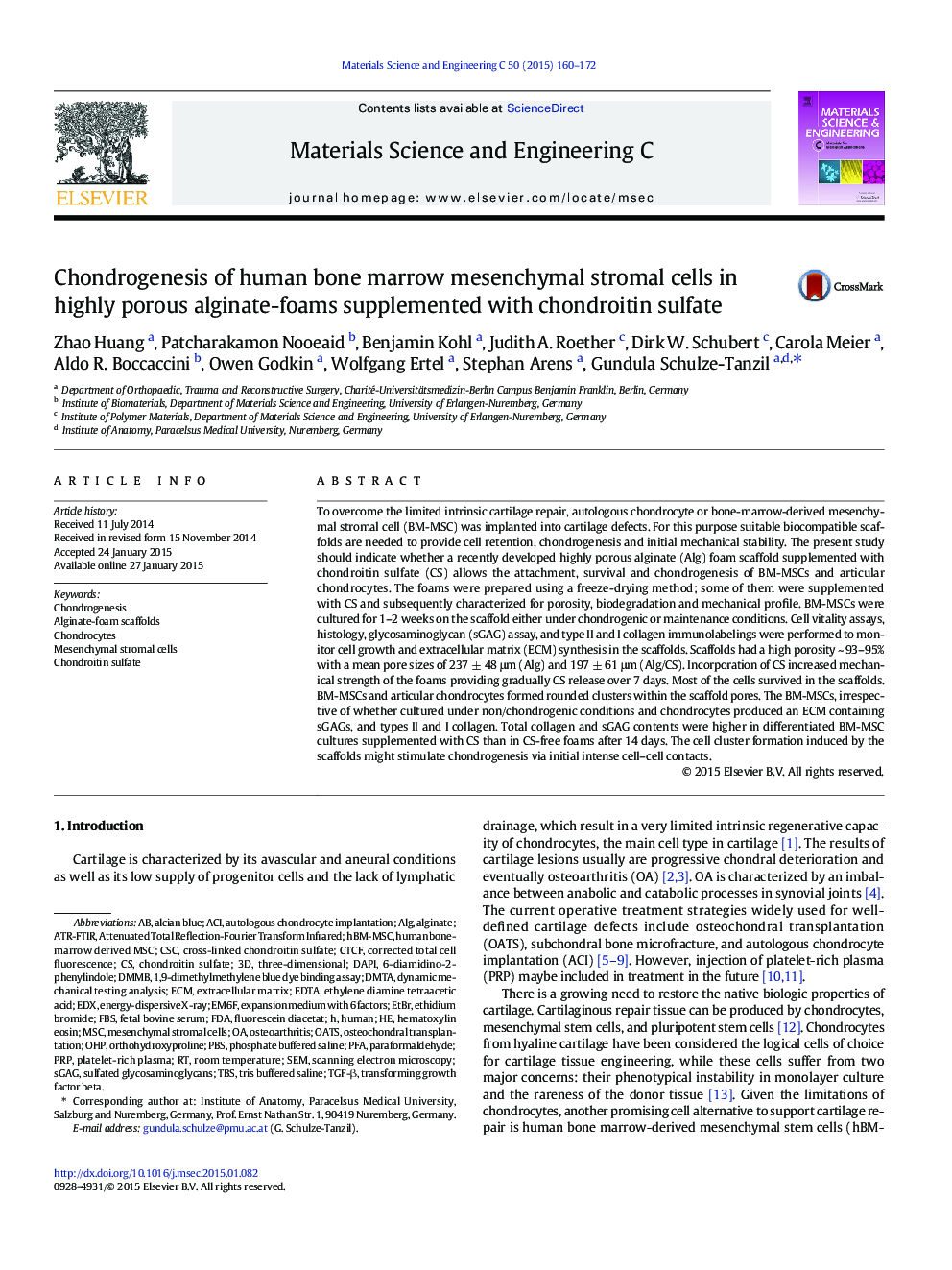| Article ID | Journal | Published Year | Pages | File Type |
|---|---|---|---|---|
| 7869698 | Materials Science and Engineering: C | 2015 | 13 Pages |
Abstract
To overcome the limited intrinsic cartilage repair, autologous chondrocyte or bone-marrow-derived mesenchymal stromal cell (BM-MSC) was implanted into cartilage defects. For this purpose suitable biocompatible scaffolds are needed to provide cell retention, chondrogenesis and initial mechanical stability. The present study should indicate whether a recently developed highly porous alginate (Alg) foam scaffold supplemented with chondroitin sulfate (CS) allows the attachment, survival and chondrogenesis of BM-MSCs and articular chondrocytes. The foams were prepared using a freeze-drying method; some of them were supplemented with CS and subsequently characterized for porosity, biodegradation and mechanical profile. BM-MSCs were cultured for 1-2 weeks on the scaffold either under chondrogenic or maintenance conditions. Cell vitality assays, histology, glycosaminoglycan (sGAG) assay, and type II and I collagen immunolabelings were performed to monitor cell growth and extracellular matrix (ECM) synthesis in the scaffolds. Scaffolds had a high porosity ~ 93-95% with a mean pore sizes of 237 ± 48 μm (Alg) and 197 ± 61 μm (Alg/CS). Incorporation of CS increased mechanical strength of the foams providing gradually CS release over 7 days. Most of the cells survived in the scaffolds. BM-MSCs and articular chondrocytes formed rounded clusters within the scaffold pores. The BM-MSCs, irrespective of whether cultured under non/chondrogenic conditions and chondrocytes produced an ECM containing sGAGs, and types II and I collagen. Total collagen and sGAG contents were higher in differentiated BM-MSC cultures supplemented with CS than in CS-free foams after 14 days. The cell cluster formation induced by the scaffolds might stimulate chondrogenesis via initial intense cell-cell contacts.
Keywords
ATR-FTIRPrPPFADAPIALGEtBrMSCCTCFTBSOHPsGAGEDXThree-dimensionalDMTAECMCSCPBSTGF-βFDAFBSosteochondral transplantationDMMB6-diamidino-2-phenylindolealcian blueAlginateethidium bromideEDTAethylene diamine tetraacetic acidOsteoarthritisEnergy-dispersive X-rayHumanAttenuated Total Reflection-Fourier Transform InfraredTransforming Growth Factor BetaTris buffered salineOatsRoom temperaturefetal bovine serumMesenchymal stromal cellsPhosphate buffered salinecorrected total cell fluorescenceExtracellular matrixSEMScanning electron microscopyhematoxylin eosinparaformaldehydeplatelet-rich plasmaAutologous chondrocyte implantationaciChondrocytesChondrogenesisChondroitin sulfateSulfated glycosaminoglycans
Related Topics
Physical Sciences and Engineering
Materials Science
Biomaterials
Authors
Zhao Huang, Patcharakamon Nooeaid, Benjamin Kohl, Judith A. Roether, Dirk W. Schubert, Carola Meier, Aldo R. Boccaccini, Owen Godkin, Wolfgang Ertel, Stephan Arens, Gundula Schulze-Tanzil,
